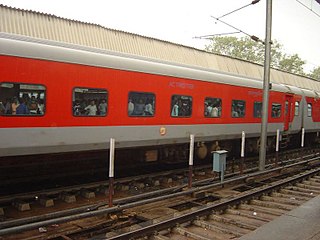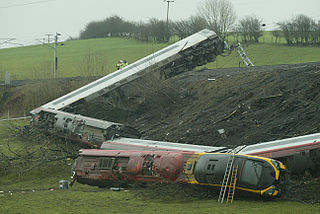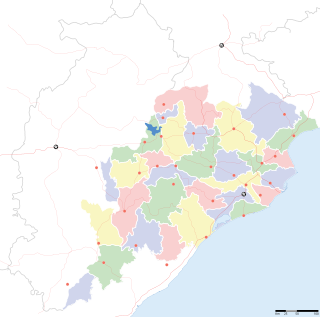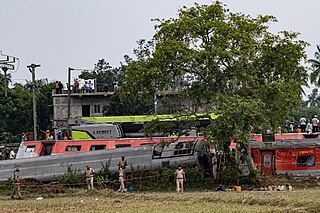Overview
The crash occurred at 10:40 p.m., when the Eastern Railway's high-speed, luxury Howrah Rajdhani Express train travelling at a speed of 130 km/h derailed on a 300-foot bridge over the Dhave River near the town of Rafiganj near Gaya. It was led by a Ghaziabad-based WAP5 locomotive.
The train had left Howrah with over 1,000 people on board six hours before, and was heading towards New Delhi. Fifteen of the 18 train cars derailed and fell across the tracks, two of them tumbling into the river beneath. People from other carriages were also thrown into the water by the force of the crash.
Rescuers, including local military personnel, were hampered by the region's poor roads, which had become muddy due to recent rain. Locals attempted to give what aid they could, and 125 people were pulled to safety by morning, but nothing could be done for those trapped in the carriages that had fallen into the swollen river.
The death toll continued to rise in the following weeks. The river was searched for bodies, and several were found near villages downstream. The full death toll is unlikely to ever be known. In all, 130 bodies were recovered, but some sources claim that as many as 50 people are still missing. Some news reports give the figure of those killed as high as 200. At least 150 people were injured.
The cause of the crash was not immediately clear, but it was originally thought that rust and metal fatigue on the colonial-era bridge contributed to a shift in the structure which cracked the rails, perhaps as a result of the heavy rains in the area. A railway employee said the bridge was known to be in poor state of repair, but as in the Kadalundi River rail disaster thirteen months earlier, nothing was done to repair the structure.
A later enquiry reported the cause as sabotage, pointing to missing "fish plates" which were intended to anchor the rails to the bridge. These had apparently been removed at some point shortly before the crash. The investigators reported that the plates had probably been removed by Naxalites, who were conducting a low-intensity guerrilla war at the time. The leaders of their organisation, the People's War Group had recently been arrested, and this was described as a being a revenge attack.
Other commentators have questioned this view, some claiming that fish plates were not missing at all, or that they were dislodged during the crash and fell into the river. Others assert that the fish plates may have been missing either through common theft for scrap metal or through the shifting of the weakened bridge shortly before the accident. The Naxalites themselves have not claimed credit for the "attack", and have never been known to target trains before.

On 3 June 1998, an ICE 1 train on the Hannover-Hamburg railway near Eschede in Lower Saxony, Germany derailed and crashed into an overpass that crossed the railroad, which then collapsed onto the train. 101 people were killed and at least 88 were injured, making it the second-deadliest railway disaster in German history after the 1939 Genthin rail disaster, and the world's worst ever high-speed rail disaster.

The Rajdhani Express is a series of passenger train services in India operated by Indian Railways connecting the national capital New Delhi with the capitals or the largest cities of various states. Rajdhani, derived from the Sanskrit means "capital". Introduced in 1969, the trains are amongst the premium services operated by Indian Railways and regularly get a higher priority on the railway network.

There have been four railway accidents at Potters Bar (England). Those in 1898 and 1946 were signals passed at danger. The accident in 2002 led to substantial public debate and a national change in policy relating to maintenance of infrastructure.

A train wreck, train collision, train accident or train crash is a type of disaster involving one or more trains. Train wrecks often occur as a result of miscommunication, as when a moving train meets another train on the same track; or an accident, such as when train wheels come off a track in a derailment; or when a boiler explosion occurs. Train wrecks have often been widely covered in popular media and in folklore.

The Shipton-on-Cherwell train crash was a major disaster which occurred on the Great Western Railway. It involved the derailment of a long passenger train at Shipton-on-Cherwell, near Kidlington, Oxfordshire, England, on Christmas Eve, 24 December 1874, and was one of the worst disasters on the Great Western Railway.
The Kadalundi train disaster occurred in India on 22 June 2001, when the Mangalore-Chennai Mail passenger train was crossing over the Kadalundi river. Three carriages fell into the water, with 59 people reported killed or missing, and up to 300 believed injured. The official inquiry concluded that the derailment was caused by one pillar of the 140-year old bridge sinking into the riverbed, following recent heavy rain, though this finding has been challenged.
The Sarai Banjara rail disaster occurred on 2 December 2000, when a derailed freight train crossed onto the opposite track early in the morning in Punjab, India. A Howrah–Amritsar Express a passenger train coming from other direction hit the freight train head-on at speed, killing 46 people and injuring at least 150.

The Kurnool train crash was the derailment and crash of a passenger train in Kurnool district in Andhra Pradesh, India, on 21 December 2002.

The Jaunpur train crash was a rail accident that occurred on 13 May 2002 in Uttar Pradesh, India. Subsequent investigation indicated that the cause was removal of plates that bind stretches of rail.

The Grayrigg derailment was a fatal railway accident that occurred at approximately 20:15 GMT on 23 February 2007, just to the south of Grayrigg, Cumbria, in the North West England region of the United Kingdom. The accident investigation concluded that the derailment was caused by a faulty set of points on the Down Main running line, controlled from Lambrigg ground frame. The scheduled inspection on 18 February 2007 had not taken place and the faults had gone undetected.
The Mehrabpur derailment was a fatal railway accident that occurred shortly after 02:00 local time on 19 December 2007 near the town of Mehrabpur in the Sindh province of Pakistan.

On 13 February 2009, a passenger train derailment occurred at 19:45 local time near Jajpur in the eastern state of Odisha, India. Nine people were killed and 150 people were injured in the incident. Twelve carriages belonging to the Howrah–Chennai Coromandel Express are believed to have derailed following the train's departure from Jajapur Keonjhar Road station near Jajapur. The cause of the accident is currently unknown.
On 13 January 1985, an express train derailed on a curved bridge over the gorge of the Awash River in Awash, Ethiopia. The official death toll was 428, with more than 500 injuries.
On 28 May 2010, a Jnaneshwari Express train derailed at about 1 a.m. in the West Midnapore district of West Bengal, India. It was disputed as to whether sabotage or a bomb caused damage on the railway track, which in turn led to the derailment, before an oncoming goods train hit the loose carriages, resulting in the deaths of at least 148 passengers.
The 2015 Gujranwala derailment occurred on 2 July 2015 when a military-special train carrying Pakistan Army unit was derailed at Gujranwala due to a bridge collapsing under it. Nineteen people were killed and over 100 were injured.

Rail sabotage is the act of disrupting a rail transport network. This includes both acts designed only to hinder or delay as well as acts designed to actually destroy a train. Railway sabotage requires considerable effort, due to the design and heavy weight of railways.

On June 2, 2023, three trains collided in Balasore district in Odisha state of eastern India. The Coromandel Express entered the passing loop instead of the main line near Bahanaga Bazar railway station at full speed and collided with a goods train. Due to the high speed of the Coromandel Express, its 21 coaches derailed and three of those collided with the oncoming SMVT Bengaluru–Howrah Superfast Express on the adjacent track.











